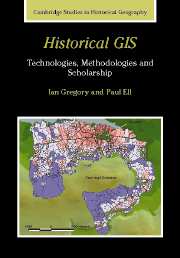Book contents
- Frontmatter
- Contents
- List of figures
- List of tables
- Acknowledgements
- 1 GIS and its role in historical research: an introduction
- 2 GIS: a framework for representing the Earth's surface
- 3 Building historical GIS databases
- 4 Basic approaches to handling data in a historical GIS
- 5 Using GIS to visualise historical data
- 6 Time in historical GIS databases
- 7 Geographic Information Retrieval: historical geographic information on the internet and in digital libraries
- 8 GIS and quantitative spatial analysis
- 9 From techniques to knowledge: historical GIS in practice
- References
- Index
6 - Time in historical GIS databases
Published online by Cambridge University Press: 23 June 2009
- Frontmatter
- Contents
- List of figures
- List of tables
- Acknowledgements
- 1 GIS and its role in historical research: an introduction
- 2 GIS: a framework for representing the Earth's surface
- 3 Building historical GIS databases
- 4 Basic approaches to handling data in a historical GIS
- 5 Using GIS to visualise historical data
- 6 Time in historical GIS databases
- 7 Geographic Information Retrieval: historical geographic information on the internet and in digital libraries
- 8 GIS and quantitative spatial analysis
- 9 From techniques to knowledge: historical GIS in practice
- References
- Index
Summary
6.1 INTRODUCTION
GIS has the ability to handle thematic (or attribute) information and spatial information to answer questions about what and where. Most information also has a temporal component that tells us when an event occurred, or when a dataset was produced. This component of information is not explicitly incorporated into GIS software, and has attracted only limited interest among GI scientists. A lack of temporal functionality in GIS software is commonly criticised. Progress in adding it has been limited, as GIS software vendors do not see this as particularly important for their market. As a result, researchers wanting to handle temporal data are largely left to make their own decisions about how they are going to do this within GIS.
Chapter 1 introduced Langran and Chrisman's (1988) idea that, faced with the complexity of data with thematic, spatial and temporal components, the traditional approach has been to fix one component, control the second and only measure the third accurately (see also Langran, 1992). They give the example of census data, where time is fixed by taking the census on a single night, and space is controlled by subdividing the country into pre-defined administrative units. The theme is the number of people counted in each unit, which is well handled at the expense of the other two components. Soils mapping gives a slightly different example.
- Type
- Chapter
- Information
- Historical GISTechnologies, Methodologies, and Scholarship, pp. 119 - 144Publisher: Cambridge University PressPrint publication year: 2007
- 1
- Cited by



